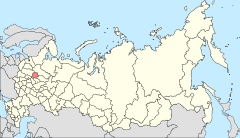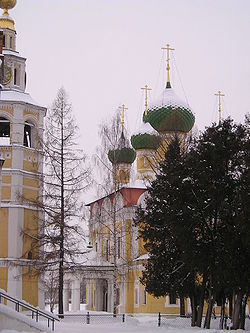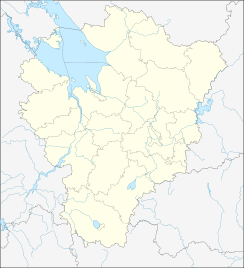- Uglich
-
Uglich (English)
Углич (Russian)- Town[citation needed] -
The Transfiguration Cathedral in the Uglich kremlin
Location of Yaroslavl Oblast in RussiaCoordinates: 57°32′N 38°20′E / 57.533°N 38.333°ECoordinates: 57°32′N 38°20′E / 57.533°N 38.333°E Coat of arms Flag Administrative status Country Russia Federal subject Yaroslavl Oblast Municipal status Mayor[citation needed] Eleanora Sheremetyeva[citation needed] Statistics Population (2010 Census,
preliminary)34,505 inhabitants[1] Population (2002 Census) 38,260 inhabitants[2] Time zone MSD (UTC+04:00)[3] Founded 937[citation needed] Dialing code(s) +7 48532[citation needed] Official website 
Uglich (Russian: У́глич, IPA: [ˈuɡlʲitɕ]) is a historic town in Yaroslavl Oblast, Russia, which stands on the Volga River. Population: 34,505 (2010 Census preliminary results);[1] 38,260 (2002 Census);[2] 39,975 (1989 Census).[4]
A local tradition dates the town's origins to 937. It was first documented in 1148 as Ugliche Pole (Corner Field). The town's name is thought to allude to the nearby turn in the Volga River.
Uglich had been the seat of a small princedom from 1218 until 1328 when the local princes sold their rights to the great prince of Moscow. As a border town of Muscovy, it was burnt several times by Lithuanians, Tatars and the grand prince of Tver.
Grand Duke Ivan III of Moscow gave the town to his younger brother Andrei Bolshoi in 1462. During Andrei's reign the town was expanded and first stone buildings were constructed. Particularly notable were the cathedral (rebuilt in 1713), the Intercession Monastery (destroyed by the Bolsheviks) and the red-brick palace of the prince (completed in 1481 and still standing).
During the reign of Ivan the Terrible the town passed to his only brother, Yury. Local inhabitants helped the Tsar capture Kazan by building a wooden fortress which was transported by the Volga all the way to Kazan. Throughout the 16th century Uglich prospered both politically and economically, but thereafter its fortunes began to decline.
After Ivan's death, his youngest son Dmitry Ivanovich was banished to Uglich in 1584. The most famous event in the town's history took place on May 15, 1591 when the 10-year old boy was found dead with his throat cut in the palace courtyard. Suspicion immediately fell on the tsar's chief advisor, Boris Godunov. Official investigators concluded however that Dimitriy's death was an accident. They cut a "tongue" from the cathedral bell that rung the news of Dimitriy's death and "exiled" it to Siberia.
As Dimitry was the last scion of the ancient Rurik dynasty, his death precipitated the dynastic and political crisis known as the Time of Troubles. People readily believed that Dimitriy was alive and supported several False Dmitriys (see False Dmitriy I, False Dmitriy II, False Dmitriy III) who tried to grab the Muscovite throne. During the Time of Troubles, the Poles besieged the Alexeievsky and Uleima monasteries and burned them down killing all the populace who had sought refuge inside.
The Romanov Tsars made it their priority to canonize the martyred tsarevich and to turn Uglich into a place of pilgrimage. On the spot where Dimitriy had been murdered the city in 1690 built the small but lovely Church of St Demetrios on the Blood, which appears on the horizon with its red walls and blue domes as one sails north on the Volga. The palace where the prince lived was turned into a museum. The image of tsarevich with a knife in his hand was adopted as the town's emblem.
In the first third of the 18th century the kremlin cathedral and its remarkable bell-tower were demolished and rebuilt. Other 18th-century landmarks include the Smolenskaya, Korsunskaya, Kazanskaya and Bogoyavlenskaya churches. The most important edifice of the 19th century is the ponderous cathedral of the Theophany Convent, consecrated in 1853.
The modern town did have a famous watch manufacturing plant now closed (see Chaika watches), a railway station, and a hydroelectric power station. In November 2008 was opened a new Nexans cable mill. Actually, Stalin's decision to create the Uglich Reservoir led to severe flooding of the town's outskirts. Apart from the kremlin, the city centre features other nice samples of old Russian architecture. Particularly notable are the Alexeievsky and Resurrection monasteries.
The Assumption three-tented church (1628) of the Alexeievsky monastery is considered a true gem of Russian medieval architecture. "Marvelous" is an epithet that common people gave to their church and which became a part of its official name. Located nearby is the more conventional Church of St. John the Baptist (1681).
Closer to the bank of the Volga one may see the Resurrection Monastery with its huge cathedral, refectory, belfry and summer church. All these buildings stand in a row and date back to 1674-77. Opposite the monastery is the graceful Church of the Nativity of St. John the Baptist. It was built in 1689-90 by a local merchant to commemorate the spot where his son had drowned.
More old architecture may be seen in the vicinity of Uglich, including the 17th-century Uleima Monastery and a fine church in Divnogorie.
References
- ^ a b Федеральная служба государственной статистики (Federal State Statistics Service) (2011). "Предварительные итоги Всероссийской переписи населения 2010 года (Preliminary results of the 2010 All-Russian Population Census)" (in Russian). Всероссийская перепись населения 2010 года (All-Russia Population Census of 2010). Federal State Statistics Service. http://www.perepis-2010.ru/results_of_the_census/results-inform.php. Retrieved 2011-04-25.
- ^ a b Федеральная служба государственной статистики (Federal State Statistics Service) (2004-05-21). "Численность населения России, субъектов Российской Федерации в составе федеральных округов, районов, городских поселений, сельских населённых пунктов – районных центров и сельских населённых пунктов с населением 3 тысячи и более человек (Population of Russia, its federal districts, federal subjects, districts, urban localities, rural localities—administrative centers, and rural localities with population of over 3,000)" (in Russian). Всероссийская перепись населения 2002 года (All-Russia Population Census of 2002). Federal State Statistics Service. http://www.perepis2002.ru/ct/doc/1_TOM_01_04.xls. Retrieved 2010-03-23.
- ^ Правительство Российской Федерации. Постановление №725 от 31 августа 2011 г. «О составе территорий, образующих каждую часовую зону, и порядке исчисления времени в часовых зонах, а также о признании утратившими силу отдельных Постановлений Правительства Российской Федерации». Вступил в силу по истечении 7 дней после дня официального опубликования. Опубликован: "Российская Газета", №197, 6 сентября 2011 г. (Government of the Russian Federation. Resolution #725 of August 31, 2011 On the Composition of the Territories Included into Each Time Zone and on the Procedures of Timekeeping in the Time Zones, as Well as on Abrogation of Several Resolutions of the Government of the Russian Federation. Effective as of after 7 days following the day of the official publication).
- ^ "Всесоюзная перепись населения 1989 г. Численность наличного населения союзных и автономных республик, автономных областей и округов, краёв, областей, районов, городских поселений и сёл-райцентров. (All Union Population Census of 1989. Present population of union and autonomous republics, autonomous oblasts and okrugs, krais, oblasts, districts, urban settlements, and villages serving as district administrative centers.)" (in Russian). Всесоюзная перепись населения 1989 года (All-Union Population Census of 1989). Demoscope Weekly (website of the Institute of Demographics of the State University—Higher School of Economics. 1989. http://demoscope.ru/weekly/ssp/rus89_reg.php. Retrieved 2010-03-23.
External links
 Media related to Uglich at Wikimedia Commons
Media related to Uglich at Wikimedia Commons- (Russian) Landmarks of Uglich
- (Russian) More landmarks of Uglich
 Chisholm, Hugh, ed (1911). "Uglich". Encyclopædia Britannica (11th ed.). Cambridge University Press.
Chisholm, Hugh, ed (1911). "Uglich". Encyclopædia Britannica (11th ed.). Cambridge University Press.
Cities and towns in Yaroslavl Oblast Administrative center: Yaroslavl Danilov · Gavrilov-Yam · Lyubim · Myshkin · Pereslavl-Zalessky · Poshekhonye · Rostov · Rybinsk · Tutayev · Uglich
Danilov · Gavrilov-Yam · Lyubim · Myshkin · Pereslavl-Zalessky · Poshekhonye · Rostov · Rybinsk · Tutayev · Uglich
Golden Ring of Russia  Categories:
Categories:- Cities and towns in Yaroslavl Oblast
- Golden Ring of Russia
- Populated places on the Volga
Wikimedia Foundation. 2010.





